Geocaching: A Modern Day Treasure Hunt
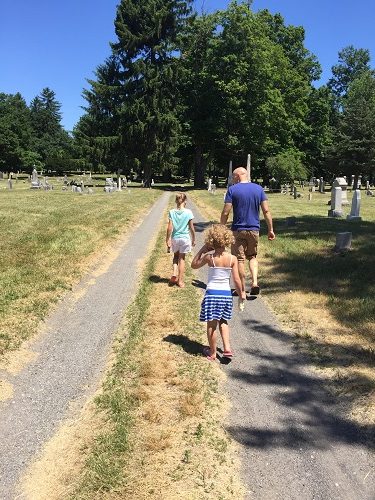
I first learned about geocaching when I wrote my last blog post, 10 Fun Ways to Get Fit in and Around the Capital District. When I started asking around about geocaching, people either knew about it and raved or had never heard of it.
First played way back in 2000, geocaching is described as an outdoor recreational activity in which participants use a mobile device and other navigational techniques to hide and seek containers, called geocaches or caches, at specific locations marked by coordinates all over the world. There are more than 2 million hidden caches waiting for us to find them! Doesn’t that very thought excite you?
When recently talking with a friend who has older children, she said they had to use actual maps to geocache! Imagine having no access to Google Maps or any other GPS-enabled devices. I had to get in on this trend and thought there was no better crew to test it on than my family. So, my two daughters, Eleanor (7½), Charlotte (5), my boyfriend Jeff (37, ha ha), and I began our hunt.
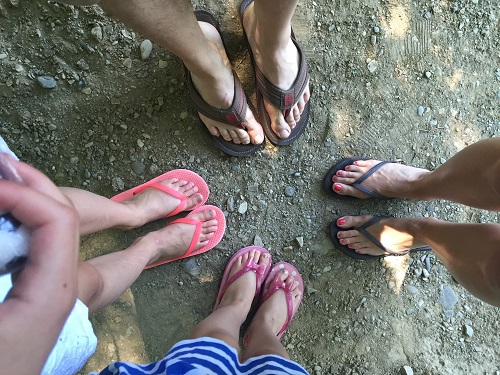
Let the Games Begin
Our first step was to download the free geocaching app on my phone. The caveat is that unlike the non-free apps that display all the hidden caches, the free one only provides details on certain caches. Of course, the caches closest to my house (our jumping-off point) were part of the paid collection, so I bit the bullet and paid for the app. With the monthly subscription, the cost came to $5.99/month. Not too bad a price for some easy family fun!
Next, we picked our first cache. As I mentioned, we ended up choosing one that was close to my house and had a fairly easy level of difficulty. All caches are rated on a scale of 1 to 10, with 10 being the most difficult, so depending on who you are with, time of year, amount of time you have, etc., you may want to choose your cache level wisely.
Along with the cache, you are given a number of clues that are supposed to help you locate it. They can range in detail from the size of the cache, to the type of terrain where you might find it, to what you will actually end up finding.
I live across from an old cemetery that dates back to the Spanish-American War (10 points to the first person who can recall the date!). No one has been buried there for many, many years, so it’s less scary and more historic, which means it’s a great place to geocache. In all our summer excitement, the four of us ran out of the house in flip-flops, which are usually a good shoe choice for summer. But as far as trekking through the cemetery and the woods goes, we found it difficult not to trip and fall. Tip: Wear sneakers to geocache, as you never know where you might end up!
As our hunt progressed, we had to do some serious navigational work. The app comes equipped with a 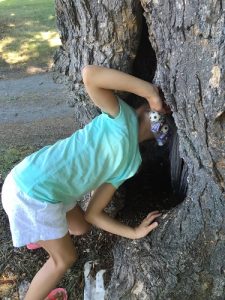 compass, which of course I had no clue how to use, but after some trial and error, I figured it out. I’m sure we looked like a family of four searching for Pokémons. Lucky for us, we managed to avoid walking into any trees or having close encounters with cars in the middle of the street. Sometimes the app can be tricky to follow—you think you are close to the mark, but then one small step in the wrong direction leads you off course. It was fun to try to figure out where the cache was hidden as we got closer. The amazing part was when the girls started looking in all the nooks and crannies because they knew we were heading in the right direction. Their excitement continued to grow as we approached our mark and we couldn’t help but smile from ear to ear.
compass, which of course I had no clue how to use, but after some trial and error, I figured it out. I’m sure we looked like a family of four searching for Pokémons. Lucky for us, we managed to avoid walking into any trees or having close encounters with cars in the middle of the street. Sometimes the app can be tricky to follow—you think you are close to the mark, but then one small step in the wrong direction leads you off course. It was fun to try to figure out where the cache was hidden as we got closer. The amazing part was when the girls started looking in all the nooks and crannies because they knew we were heading in the right direction. Their excitement continued to grow as we approached our mark and we couldn’t help but smile from ear to ear.
As we got closer to the mark, my older daughter, Eleanor, ran to what looked like a hollowed-out tree. With little sister Charlotte not far behind, I made them slow down and wait for everyone to catch up. Remember the flip-flop situation? It’s not so easy for this 35-year-old 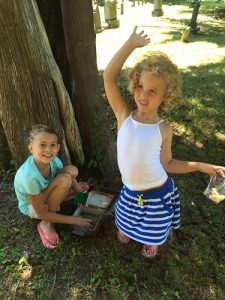 mother of two to run in those things! Eleanor climbed up on the stump, looked down into the tree, and let out a huge scream! We may have woken the dead or at least startled the other people in the cemetery walking dogs.
mother of two to run in those things! Eleanor climbed up on the stump, looked down into the tree, and let out a huge scream! We may have woken the dead or at least startled the other people in the cemetery walking dogs.
We reached in and pulled out a tin box about the size of a lunchbox. In the box was a small notepad where we wrote our names and the date. We also collected one of the other prizes that was left in the box for those lucky enough to locate it (a coffee table coaster!). We had brought some small trinkets with us, including a bouncy soccer ball from Eleanor’s seventh birthday party, and left them in place of the prize we took. Tip: Make sure you bring a pen and small trinket with you on every geocache so you can record your discovery and leave a small surprise for the next person!
On to Round Two
We were so excited about our find that we decided to keep going and look for a second cache, also 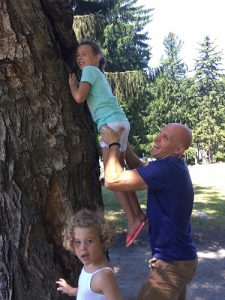 hidden in the cemetery, but on the opposite side. The girls started to get tired on the walk to the second cache, since by that time, the excitement from the first find had started to wear off. The second cache was a little higher on the difficulty scale, so I approached it with managed expectations.
hidden in the cemetery, but on the opposite side. The girls started to get tired on the walk to the second cache, since by that time, the excitement from the first find had started to wear off. The second cache was a little higher on the difficulty scale, so I approached it with managed expectations.
Unfortunately we did not have as much luck the second time around, as this cache was much smaller. I found it funny that one of the hints compared it to the size of a film canister. I asked my girls what a film canister was and they didn’t even know what film was (#oldmom)! We walked around the woods for almost 15 minutes (the equivalent of 47 hours to a 5 year old) looking for it. We moved brush, kicked around dirt (still in our flip-flops and now with a not-so-perfect pedicure), and could not find the cache. The girls were slightly disappointed, but I reassured them that we could try again another day and that seemed to calm the storm.
The Verdict?
This is, without a doubt, an activity my family and I will participate in again. What’s exciting is no matter where you are, you can research what caches are nearby, so it’s a game you can take with you, and it packs up better than Chutes and Ladders!
I hope this post has been informational and fun to read. I look forward to hearing about your Geocaching experiences, so please share!
 The Daily Dose
The Daily Dose
Chris
Spanish American War 1898